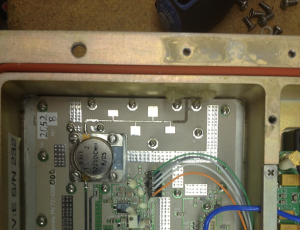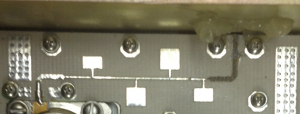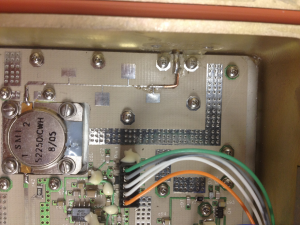The BMS Truck-Coder II [1] is a professional transmitter for Electronic News-Gathering (ENG) applications. The transmitter operates in the 2 GHz or 7 GHz Broadcast Auxiliary Service (BAS) frequency range. A complete setup consist out of a control unit, an outdoor RF unit (ODU) and an antenna.
Even though these devices are pretty rugged, an ENG truck operator at a local TV station managed to break off the whole flanged N type connector. Together with the N connector, a piece of the output low-pass filter’s microstrip transmission line got ripped straight off the PCB.
Being under time and budgetary pressure, I came up with a pretty simple yet effective fix. I found a piece of copper wire with the same diameter as the microstrip line. To straighten the copper wire up and make it more tense, I stretched it lightly between two pliers. A short piece of this copper wire was cut and bent so that it would be long enough to connect the microstrip and the new flanged N connector.
I didn’t think this quick and dirty fix would degrade the output signal in any way. And sure enough, a quick check with a RF power detector and a spectrum analyzer revealed that this device was now actually performing better (output power and spectral purity) than a different ODU I compared it against.
Links and Sources:
[1] Truck-Coder II, BMS: http://www.bms-inc.com/wp-content/uploads/2012/07/ENGTruckSystem.pdf
Westerhold, S. (2012), "Fixing a microstrip line in a professional Microwave ODU". Baltic Lab High Frequency Projects Blog. ISSN (Online): 2751-8140., https://baltic-lab.com/2012/10/fixing-a-stripline-in-a-professional-microwave-odu/, (accessed: November 4, 2025).
- WebP-Images without Plugin - January 14, 2025
- Firewall Rules with (dynamic) DNS Hostname - January 14, 2025
- Restoring proxied visitor IPs from Cloudflare - December 26, 2024



sam
well i have 3 defective units, all give me ODU alarm. do you know any other problem then what you described?